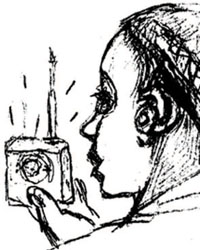Sensory impairments
Visual impairments
Virtually everyone will experience a visual impairment at some point in their lives. Usually these are minor or treatable, e.g. temporary visual impairments caused by bright lights or headaches, or age-related visual impairment that can be 'self-treated' with reading spectacles. But they can also be serious, e.g. permanent visual impairment or more severe conditions requiring medical treatment. Visual impairment can be congenital (present at birth), due to genetic conditions, or the result of accidents, violence, or diseases such as trachoma, glaucoma and cataracts (you learned about this in Study Session 5).
Hearing impairments

There is a wide variety in the form and severity of hearing impairments, ranging from partial to complete deafness. People who are partially deaf can often use hearing aids to assist their hearing (Figure 19.2).
Deafness can be genetic, be evident at birth, or occur later in life as a result of disease or due to old age. Both deaf and partially deaf people use sign language as a means of communication. The lack of knowledge of sign language amongst the general population can create communication difficulties for deaf and partially deaf people and can also be thought of as a disabling barrier.